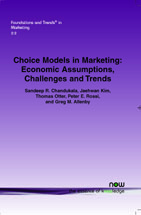Choice Models in Marketing: Economic Assumptions, Challenges and Trends
By Sandeep R. Chandukala, Kelley School of Business, Indiana University, USA, sarchand@indiana.edu | Jaehwan Kim, Korea University Business School, Korea University, Korea, jbayes@korea.ac.kr | Thomas Otter, Department of Marketing, Johann Wolfgang Goethe-Universität Frankfurt, Germany, otter@marketing.uni-frankfurt.de | Peter E. Rossi, Graduate School of Business, University of Chicago, USA, peter.rossi@chicagogsb.edu | Greg M. Allenby, Fisher College of Business, Ohio State University, USA, allenby_1@fisher.osu.edu
Abstract
Direct utility models of consumer choice are reviewed and developed for understanding consumer preferences. We begin with a review of statistical models of choice, posing a series of modeling challenges that are resolved by considering economic foundations based on constrained utility maximization. Direct utility models differ from other choice models by directly modeling the consumer utility function used to derive the likelihood of the data through Kuhn-Tucker conditions. Recent advances in Bayesian estimation make the estimation of these models computationally feasible, offering advantages in model interpretation over models based on indirect utility, and descriptive models that tend to be highly parameterized. Future trends are discussed in terms of the antecedents and enhancements of utility function specification.
Choice Models in Marketing
Choice Models in Marketing examines recent developments in the modeling of choice for marketing and reviews a large stream of research currently being developed by both quantitative and qualitative researches in marketing. Choice in marketing differs from other domains in that the choice context is typically very complex, and researchers' desire knowledge of the variables that ultimately lead to demand in marketplace. The marketing choice context is characterized by many choice alternatives. The aim of Choice Models in Marketing is to lay out the foundations of choice models and discuss recent advances. The authors focus on aspects of choice that can be quantitatively modeled and consider models related to a process of constrained utility maximization. By reviewing the basics of choice modeling and pointing to new developments, Choice Models in Marketing provides a platform for future research.
